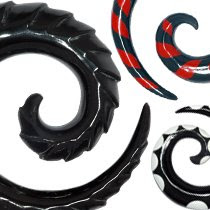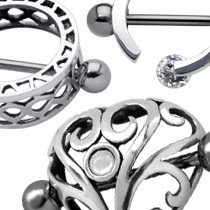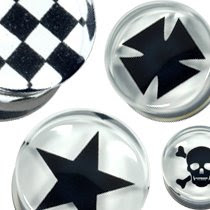Body piercing retainers are designed to be discreet, whilst keeping your piercing open. Piercing retainers are commonly made from transparent acrylics such as Bioplast, Bioflex and PTFE but can also come in a variety of metals for hidden piercings such as the Septum.
 This Titanium septum retainer can be flipped up into your nose, out of sight!
This Titanium septum retainer can be flipped up into your nose, out of sight!
Any acrylic retainer can be worn during medical procedures, x-rays and scans as they do not contain any metal. Piercing retainers are also ideal for wearing to work, school and for playing sports to prevent injury. Piercing retainers are very versatile and can be used for virtually any piercing you have, from nostrils, eyebrows and navels to stretched ears and genital piercings. We have a wide selection of retainers to choose from, in many different sizes and shapes.
The best thing about Bioplast, Bioflex and PTFE acrylic is the ability to autoclave (pressure-steam sterilize) the retainer for initial piercings, so you can request to be pierced with a retainer at your piercing studio. If you need to change your existing jewellery for a retainer before your piercing has healed you can ask your piercer to autoclave and fit the retainer for you.
Different Types of Piercing Retainers
Here is an overview of the different types of retainers you can find and the piercings they are most commonly worn in. Remember, body piercing jewellery and piercing retainers can be used to your own personal requirements; as long as they fit your piercing size correctly you can wear them wherever you choose or need to!
Labret Retainers:
 Labret retainers are very versatile and come in a variety of styles, including clear-top, flesh-tone, beauty-spot-black and clear o-ring. Labret retainers are also known as ‘lip retainers’, however, they are not only used for lip, labret and monroe piercings but also earlobes, tragus and other cartilage ear piercings. The soft acrylic material and flat base plate on labret retainers make them incredibly comfortable to wear in ear piercings, whilst also preventing injury or damage to the teeth and gums for oral piercings. Labret retainers are available in two gauges (thicknesses); 1.2mm and 1.6mm, and 3 different lengths; 6mm, 8mm and 10mm.
Labret retainers are very versatile and come in a variety of styles, including clear-top, flesh-tone, beauty-spot-black and clear o-ring. Labret retainers are also known as ‘lip retainers’, however, they are not only used for lip, labret and monroe piercings but also earlobes, tragus and other cartilage ear piercings. The soft acrylic material and flat base plate on labret retainers make them incredibly comfortable to wear in ear piercings, whilst also preventing injury or damage to the teeth and gums for oral piercings. Labret retainers are available in two gauges (thicknesses); 1.2mm and 1.6mm, and 3 different lengths; 6mm, 8mm and 10mm.
Nostril Retainers:
 Our Nose Piercing Retainers are available in two different designs; the professional hook nose screw studs that 'twist' into your nose piercing, or the straight nose pins that have one straight stem. Nostril retainers are also available in different gauges (thicknesses) to ensure you have a perfect fit! The most common nostril piercing size will be 1mm, but we also have 0.8mm and 1.2mm for those who may have downsized or stretched up.
Our Nose Piercing Retainers are available in two different designs; the professional hook nose screw studs that 'twist' into your nose piercing, or the straight nose pins that have one straight stem. Nostril retainers are also available in different gauges (thicknesses) to ensure you have a perfect fit! The most common nostril piercing size will be 1mm, but we also have 0.8mm and 1.2mm for those who may have downsized or stretched up.
Tongue Retainers:
 Tongue retainers come in a variety of colours and shapes, with a standard length of 16mm that can easily be cut down to length and re-threaded for a perfect fit (re-threading of acrylic stems is explained further on in this article). The most secure retainers for tongue piercings would be the dome-topped barbells, available in transparent clear, flesh-tone and pink. The dome-top is threaded onto the end of the bar, ensuring to stay in place just like any standard threaded barbell.
Tongue retainers come in a variety of colours and shapes, with a standard length of 16mm that can easily be cut down to length and re-threaded for a perfect fit (re-threading of acrylic stems is explained further on in this article). The most secure retainers for tongue piercings would be the dome-topped barbells, available in transparent clear, flesh-tone and pink. The dome-top is threaded onto the end of the bar, ensuring to stay in place just like any standard threaded barbell.
Curved Retainers:
 Curved Bioplast retainer stems can be used for eyebrow piercing, navel piercings and any other piercing that will fit the size of the stem correctly. We have them in both 1.2mm and 1.6mm gauges, at a long length of 25mm that can be cut down and re-threaded for a perfect fit. More information on re-threading acrylic can be found further below. A flat base-plate is fixed to one end of the curved retainer stem, but you can choose to add your own accessory onto the other end of the stem. We have a selection of accessories to use for securing retainers in place, shown further below.
Curved Bioplast retainer stems can be used for eyebrow piercing, navel piercings and any other piercing that will fit the size of the stem correctly. We have them in both 1.2mm and 1.6mm gauges, at a long length of 25mm that can be cut down and re-threaded for a perfect fit. More information on re-threading acrylic can be found further below. A flat base-plate is fixed to one end of the curved retainer stem, but you can choose to add your own accessory onto the other end of the stem. We have a selection of accessories to use for securing retainers in place, shown further below.
Silicone Flesh Plug Retainers:
 If you have stretched your piercings and need larger gauge hiders to keep them discreet, these flesh-tone silicone hider plugs are the way to go! Available in a great range of sizes from 2.4mm to 19mm, these stretched-piercing retainers are flexible and soft, making them easy and comfortable to wear for any occasion.
If you have stretched your piercings and need larger gauge hiders to keep them discreet, these flesh-tone silicone hider plugs are the way to go! Available in a great range of sizes from 2.4mm to 19mm, these stretched-piercing retainers are flexible and soft, making them easy and comfortable to wear for any occasion.
Circular Barbell Retainers:
 These 1.2mm micro-circular barbells are available in 1.2 x 8mm, commonly worn in micro septum, earlobe, tragus and cartilage piercings that fit this gauge and internal diameter. Both ends of the circular barbell stems are threaded to fit any 1.2mm accessory, although you can also use our range of push-fit balls and o-rings, shown further below…
These 1.2mm micro-circular barbells are available in 1.2 x 8mm, commonly worn in micro septum, earlobe, tragus and cartilage piercings that fit this gauge and internal diameter. Both ends of the circular barbell stems are threaded to fit any 1.2mm accessory, although you can also use our range of push-fit balls and o-rings, shown further below…
Barbell Stems:
 We have a wide selection of barbell stem retainers that can be used for different piercings as required by you, from lip, labret and monroe piercings to cheek, eyebrow, nipple, conch, tongue and other piercings that fit the gauge and length of the stem correctly.
We have a wide selection of barbell stem retainers that can be used for different piercings as required by you, from lip, labret and monroe piercings to cheek, eyebrow, nipple, conch, tongue and other piercings that fit the gauge and length of the stem correctly.
Barbell stem retainers come in a variety of styles, including a straight barbell without any fixed ends, or with a fixed base-plate in the form of a ball, or flat disc or half-ball (dome).
Barbell stems are available in both 1.2mm and 1.6mm gauges, with varying lengths that can easily be cut down and re-threaded to fit virtually any piercing perfectly!
We also have long strips of PTFE stem (which can also be purchased as a set with a Threading Tool) as shown below, which can be cut down and worn in any piercing that fits either 1.2mm or 1.6mm gauges. More information on re-threading of your acrylics can be found further below.
 Piercing Retainer Accessories:
Piercing Retainer Accessories:
Piercing retainers can be held in place using push-fit balls or o-rings, which can be easily fitted by pushing them onto the end of the stem. Push-fit labret retainers will be supplied with their own push-fit accessories, which will fit into the hollow stem of the stud.

Push-fit balls, silicone o-rings and Bioflex discs are available in different sizes, so you can use them on both 1.2mm and 1.6mm stems.

Cutting and Re-Threading your Bioplast, Bioflex and PTFE Stems
Acrylic stems are flexible and soft, therefore can be easily cut down to your desired length and threaded for a custom, snug fit in your piercing.
Simply trim the retainer stem at a slight angle (remember to allow some space for the thread when measuring the length!) and use the Threading Tool to push and twist a new thread on the end of the stem; quick and easy!
 If you do not have this handy little tool, not to worry! You can do the same thing using a metal threaded accessory by pushing and twisting it onto the stem, which will screw a new thread onto your stem (but may be slightly trickier!).
If you do not have this handy little tool, not to worry! You can do the same thing using a metal threaded accessory by pushing and twisting it onto the stem, which will screw a new thread onto your stem (but may be slightly trickier!).
Other Acrylic Body Piercing Jewellery
 Acrylic Smooth Segment Rings are a cheap and lightweight alternative to heavy large gauge jewellery. They are very easy to open and close, and are perfect for PA piercings where metal jewellery is not an option. These smooth segment rings are ideal for healed piercings only, as they cannot be autoclaved.
Acrylic Smooth Segment Rings are a cheap and lightweight alternative to heavy large gauge jewellery. They are very easy to open and close, and are perfect for PA piercings where metal jewellery is not an option. These smooth segment rings are ideal for healed piercings only, as they cannot be autoclaved.
 Acrylic Ball Closure Rings are available in a range of sizes and colours. The captive accessory is easy to remove and fit, making these rings quick and easy to use!
Acrylic Ball Closure Rings are available in a range of sizes and colours. The captive accessory is easy to remove and fit, making these rings quick and easy to use!

 Microdermal piercings are great for body modification where only one visible threaded accessory is desired, such as a ‘Third-Eye’ Microdermal, placed in between the eyebrows.
Microdermal piercings are great for body modification where only one visible threaded accessory is desired, such as a ‘Third-Eye’ Microdermal, placed in between the eyebrows. View our full range of Blackline Dermal Anchors and Accessories!
View our full range of Blackline Dermal Anchors and Accessories! View our full range of Titanium Dermal Anchors and Accessories!
View our full range of Titanium Dermal Anchors and Accessories!








 Piercing Retainer Accessories:
Piercing Retainer Accessories: 










 Picture 6 - 7 Months in
Picture 6 - 7 Months in






















